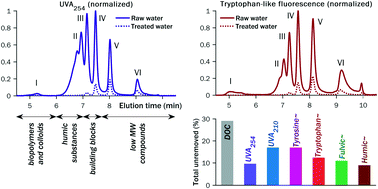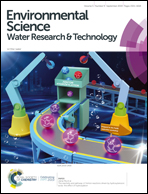Step-by-step analysis of drinking water treatment trains using size-exclusion chromatography to fingerprint and track protein-like and humic/fulvic-like fractions of dissolved organic matter†
Abstract
This paper provides a glimpse into the removal of dissolved organic matter (DOM) during conventional drinking water treatment and evaluates the potential of high-performance size-exclusion chromatography (HPSEC) as a supplementary tool for routine monitoring of drinking water treatment plants (DWTPs). Two DWTPs in Central Finland were systematically evaluated using HPSEC with simultaneous UV and fluorescence detection. For tyrosine-like, tryptophan-like, and humic/fulvic-like DOM fractions of various molecular weight (MW) values, the total and step-by-step removal efficiencies were estimated along the treatment trains. Overall, both DWTPs removed ∼70% of dissolved organic carbon (DOC) and reduced by 80–90% the total fluorescence and total UV absorbance (UVA). DOM fractions of high MW > 1500 Da were efficiently >95% removed. Fractions of intermediate MW 750–1500 Da were 80–90% removed, whereas the removal efficiency for fractions of low MW < 600 Da was in the range of 60–70%. The lowest removal efficiency across all fractions and detection was observed by UVA210 for the DOM fraction of small MW < 300 Da, for which only 20–30% was removed. In one of the DWTPs, the chromatographic area of this fraction occasionally increased, indicating the formation of degradation and/or oxidation products. Pre-ozonation of raw water reduced total tyrosine- and tryptophan-like fluorescence by ∼30%, humic/fulvic-like fluorescence by ∼20%, and total UVA254 by ∼25%. In the conventional coagulation/flocculation, high MW fractions were removed almost completely, whereas the removal of low MW fractions was only ∼20%. The coagulability of individual fractions was correlated with their hydrophobicity/hydrophilicity estimated using the ratio of UVA210/UVA254. In one of the DWTPs, oxidation with ClO2 induced the formation of DOM with MW 750–1500 Da due to the polymerization or release of DOM from colloidal matter. This new DOM was partly removed in the subsequent sand and activated carbon (AC) filtration and partly ended up in the treated water. In the AC filters, 20–60% of DOM fractions of low MW < 600 Da were removed, and fluorescent compounds exhibited two-fold higher removal efficiencies compared to UV absorbing compounds. Analyses of SUVA and the ratio of UVA210/UVA254 provided surrogate quantification of the aromatic character and hydrophobic/hydrophilic properties of unfractionated and fractionated DOM.



 Please wait while we load your content...
Please wait while we load your content...